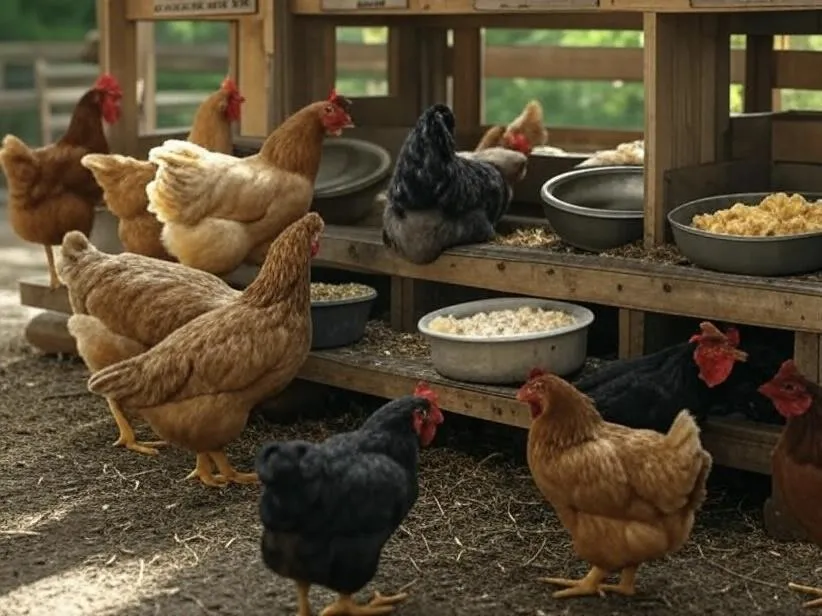
What is the Best Way to Feed Chickens?
The Costly Mistake I Made Feeding My Chickens—And How It Nearly Ruined My Flock
The frost was already forming along the edges of the coop when I stepped outside that morning. My breath curled into the air, vanishing as quickly as it came. The brittle grass crunched under my boots, the sharp cold of dawn clinging to everything it touched.
It had been a long night—one of those restless ones where you wake up at 2 AM, convinced you heard something outside. The kind where you lie still, waiting for the sound again, wondering if it was just the wind or something worse.
By now, the sun should have been making its slow rise over the trees, spilling light into the yard. And by now, the chickens should have been waiting at the door, eager and clucking, shuffling in that impatient way that says, Hurry up, we’re hungry.
But they weren’t.
A few of them lingered under the roosts, feathers puffed out against the cold, eyes half-lidded and dull. Some weren’t moving much at all, standing still as statues, their breath barely visible in the crisp morning air.
And the worst part? The egg boxes, usually filled with warm, fresh eggs by this time, were nearly empty.
Something was wrong.
This wasn’t a slow decline. This was a sharp drop—a warning sign.
I had been raising chickens long enough to know that egg production doesn’t just stop overnight.
It’s a symptom, a signal that something is off in the delicate balance of nutrition, stress, and environment.
And I was about to learn the hard way that I had been feeding them all wrong.
The Feeding Mistake That Cost Me More Than I Ever Expected
I had always believed that chickens were natural foragers. That’s what the old-timers said, and it’s what I had read in countless books.
"Just scatter the feed," they said. "They’ll find it."
It made sense, didn’t it? Chickens scratch the ground. It’s in their nature. If they could peck their way through the dirt for bugs and seeds, surely they could manage a little grain on the ground.
So I did. Every morning, I’d take a scoop of feed and toss it onto the earth. I liked the way it looked—the way they scratched, pecked, chased after the pieces. It seemed natural, and it felt right.
But that morning, as I stood in the half-lit coop, I realized it had all gone terribly wrong.
Because the feed was gone.
All of it.
Not eaten. Gone.
The ground, where I had been scattering their food, was riddled with rat holes. Tiny tracks in the dirt. Dark pellets of droppings scattered between the straw. Signs that I had unknowingly been feeding more than just my chickens.
And the worst part? The feed that was being eaten by my flock had been contaminated—mixed with dirt, manure, and whatever bacteria had been growing overnight.
This was why they weren’t laying. This was why they were lethargic.
I wasn’t feeding my birds.
I was poisoning them.
The Wake-Up Call: Chickens Don’t Just Need Food—They Need a Feeding System
I had a choice to make.
I could keep doing what I had always done—keep losing feed, dealing with rodent problems, watching my egg production drop—or I could fix the system.
Because here’s what no one tells you about feeding chickens:
It’s not just about what you feed them. It’s about HOW you feed them.
And the difference between a thriving flock and a struggling one comes down to knowing the right system.
What I Learned About Feeding Chickens the Right Way
I spent the next several weeks testing everything—different feeders, different schedules, different approaches.
And what I found changed everything.
1. Feeders Matter More Than You Think
For years, I thought the simplest way was the best way. Just toss the food down and let them eat. But that was the old way of thinking.
Once I switched to a proper feeding system, everything changed.
✔ Gravity Feeders—kept food dry, clean, and rodent-free.
✔ Treadle Feeders—only opened when a chicken stepped on them, keeping pests completely out.
✔ Hanging Feeders—reduced waste and made sure every chicken got their share.
Just changing the feeder alone cut my feed waste by over 40%.
2. How You Schedule Feedings Affects Egg Production
Before, I had no schedule—just tossed food out whenever I got to it.
But I realized chickens thrive when they have a predictable feeding routine.
Laying hens needed consistent access to food for maximum egg production.
Meat birds benefited from twice-a-day feeding, preventing excessive weight gain.
Chicks needed a constant supply of starter feed to support rapid growth.
The more structured I became, the better they performed.
3. The Secret Weapon: Hydroponic Fodder
This was the game-changer.
After fixing my feeder and schedule, I still wanted to find a way to lower feed costs while boosting nutrition.
That’s when I discovered hydroponic fodder.
Instead of relying entirely on grain, I started sprouting barley in trays—growing lush, living feed in just seven days.
And the results?
My feed bill dropped nearly 50%.
My chickens laid richer, darker-yolked eggs.
Their health improved, and their feathers became shinier.
This wasn’t just a minor improvement.
It was a total transformation.
The Final Shift: From Wasting Feed to Feeding Smarter
After all the trial and error, I finally understood what makes the difference between wasted feed and wasted money versus a thriving, productive flock.
Stop feeding on the ground. It wastes food and attracts pests.
Use the right feeder. Gravity, treadle, or hanging feeders protect feed from rodents and weather.
Stick to a schedule. Chickens do best with a structured feeding routine.
Supplement with fresh fodder. Hydroponic fodder cuts feed costs and improves nutrition.
I had learned the hard way.
But you don’t have to.
The Lesson I Wish I Knew Sooner
Raising chickens isn’t just about keeping them alive—it’s about helping them thrive.
And the fastest way to do that is to fix your feeding system before it becomes a problem.
So here’s my question for you:
Are you feeding your chickens—or are you feeding everything else, too?
Because the moment you fix that, everything changes.
